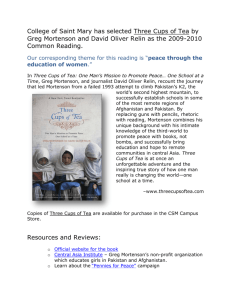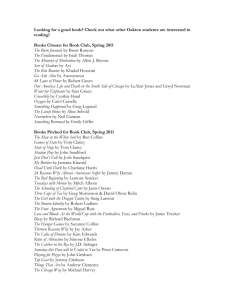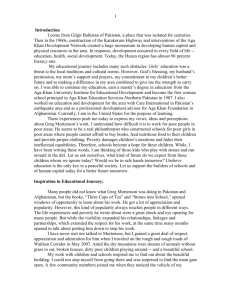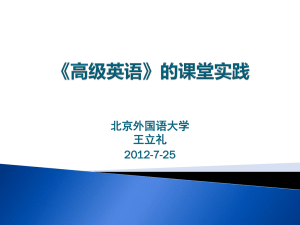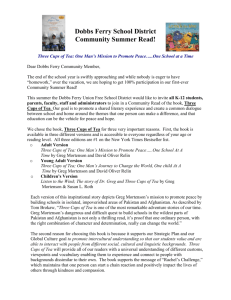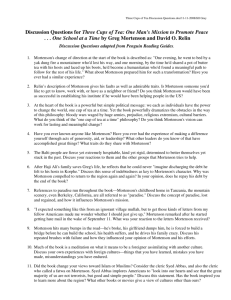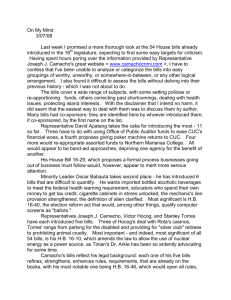Three Cups of Tea
advertisement
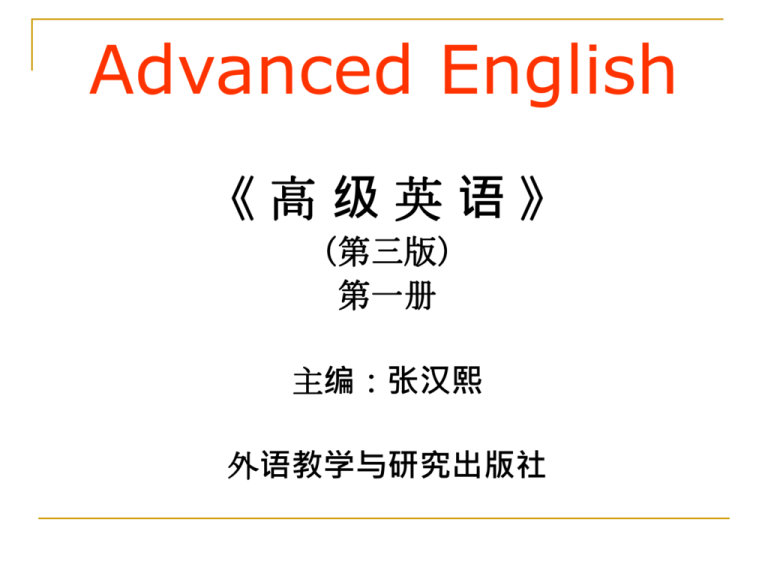
Advanced English 《高级英语》 (第三版) 第一册 主编:张汉熙 外语教学与研究出版社 Lesson 8 Three Cups of Tea (Excerpts) by Greg Mortenson and David O. Relin Teaching Points I. Background information II. Introduction to the text III. Language points IV. Text analysis V. Questions for discussion I. Background Information 1. Greg Mortenson 2. Three Cups of Tea 3. K2 4. Characters in Chapter 12 of Three Cups of Tea 1. Greg Mortenson Born on 27 December 1957, Greg Mortenson is an American humanitarian, writer and former mountaineer. He and Dr. Jean Hoerni co-founded the non-profit Central Asia Institute and he is its executive director. He also founded the educational charity Pennies for Peace. He is the protagonist and co-author of the No. 1 New York Times bestseller Three Cups of Tea, published in 2006. The sequel, Stones into Schools was released in 2009. In the spring of 1958 when Greg was only three months old, his parents moved their family from Minnesota to East Africa to teach in a girls’ school and four years later helped establish Tanzania’s first teaching hospital on the sloped of Mount Kilimanjaro. He and his sisters attended a school where children were from more than two dozen different countries. Mortenson’s mother founded the International School Moshi in 1969. From his parents Greg inherited compassion for the local poor people. At the age of 11 Greg climbed to the summit of Mount Kilimanjaro. From his parents Greg inherited two things: love for climbing and compassion for the poor and unprivileged. After moving back to the U.S., Mortenson served in the U.S. army in Germany from 1975 to 1977 as a medic, and received the Army Commendation Medal. He attended Concordia College, Moorhead, from 1977 to 1979 on an athletic scholarship. After transferring, using a GI scholarship, he later graduated from the University of South Dakota in Vermillion, South Dakota, in 1983 with an Associate Degree in Nursing and a Bachelor’s Degree in Chemistry. He had long dreamed of finding a cure for his younger sister Christa’s epilepsy, and won admission to medical school at Case Western Reserve University, but his father died while Greg was still in college, and the family’s finances were in difficulty. Greg dropped his plans for medical school and returned home to help support his family. In July 1992, Mortenson’s young sister died on her 23rd birthday from a life-long struggle with sever epilepsy. In 1993, to honor his deceased sister’s memory, Mortenson joined an expedition to scale K2, the world’s second highest mountain, Located in the Karakoram Range, K2 is the most difficult peak in the world and the ultimate test for mountaineers. After more than 70 days on the mountain, Mortenson and three other climbers completed a life-saving rescue of a climber, which took more than 75 hours. The time and energy devoted to this rescue prevented him from attempting to reach the summit. After the rescue, he began his descent of the mountain and became weak and exhausted. Mortenson took a wrong turn along the way and ended up in Korphe, a small village. The village head Haji Ali gave him food and the warmest quilt and Mortenson recovered form hunger, cold and fatigue. To pay the remote community back for their generosity and hospitality, Moretenson promised to build a school for the village where there had been no for sis hundred years. After a frustrating time trying to raise money, Mortenson convinced Jean Hoerni, a Silicon Valley pioneer, to fund the building of the Korphe School. After talking with Mortenson, Hoerni asked him to be the director of the Central Asia Institute. The mission CAI – a non-profit organization – is to promote education and literacy. Hoerni appointed Mortenson as the first executive director of CAI. A promise has turned into a longtime mission. After the completion of the school in Korphe, Mortenson went on to build more schools in northern mountain areas in Pakistan. In the process of building schools, Mortenson overcame all sorts of hardships and on top of these, he survived an eight-day armed kidnapping by the Taliban in the tribal areas of Waziristan, escaped a firefight between Afghan opium warlords and received hate mail and threats from fellow Americans for helping educate Muslim children. Mortenson believes that education and literacy for children, especially girls, in the remote and underserved areas is the most important investment all countries can make to create stability, bring socioeconomic reform, decrease infant mortality, decrease the population explosion, and improve health, hygiene, and sanitation standards globally. Mortenson believes that violence should not be fought with violence, but that there should be a global priority to promote peace through education and literacy, with an emphasis on girls’ education. Later his project extended to building schools in Afghanistan. His efforts in building schools in this war-ridden country are documented in his second book Stones into Schools. Up to 2010, the Central Asia Institute has successfully established 145 schools in Pakistan and Afghanistan, which have provided education to over 64,000 students, with an emphasis on girls’ education. In 2010 the New York Times reported that Mortenson’s approach of building schools as a way of improving the situation in Pakistan and Afghanistan is being embraced by the U.S. military. Top military officials are reading his book Three Cups of Tea, and General Petraeus has had meeting with him. The article reported that in 2009 Admiral Mike Mullen, Chairman of the Joint Chiefs of Staff, attended the opening of one of Mortenson’s schools in a remoter village of Afghanistan. Mortenson received the Star of Pakistan, Pakistan’s highest civilian award granted by the Government of Pakistan in 2009. He was nominated for the Nobel Peace Prize in 2009. In Novmber 2009, U.S News &World Report magazine featured Greg Mortenson as one of America’s Top Twenty Leaders in 2009. Mortenson has won dozens of awards, and has been granted honorary doctorates by more than a dozen universities. Greg Mortenson’s wife is Dr. Tara Bishop, a clinical psychologist, whose father was a National Geographic photographer and a climber. They live in Montana with their two children. 2. Pakistan Pakistan, officially the Islamic Republic of Pakistan is a sovereign country in South Asia. It sits at the crossroads of the strategically important regions of South Asia, Central Asia and the Middle East. It has a 1,046-kilometre coastline along the Arabian Sea and the Gulf of Oman in the south and is bordered by India to the east, Afghanistan to the west and north, Iran to the southwest and China in the far northeast. A Map of Pakistan Pakistan is a federal parliamentary republic consisting of four provinces and four federal territories. With a population exceeding 170 million people, it is the sixth most populous country in the world and has the largest Muslim population after Indonesia. It is an ethnically and linguistically diverse country, with a similar variation in its geography and wildlife. Pakistan's post-independence history has been characterized by periods of military rule, political instability and conflicts with neighbouring India. The country continues to face challenging problems, including terrorism, poverty, illiteracy and corruption. Pakistan is a democratic parliamentary federal republic with Islam as the state religion. Administrative divisions Pakistan is a federation of four provinces: Punjab, Sindh, Khyber Pakhtunkhwa and Balochistan, as well as the Islamabad Capital Territory and the Federally Administered Tribal Areas in the northwest, which include the Frontier Regions. The government of Pakistan exercises de facto jurisdiction over the western parts of the disputed Kashmir region, organised into the separate political entities Azad Kashmir and Gilgit–Baltistan (formerly Northern Areas). The Gilgit–Baltistan Empowerment and SelfGovernance Order of 2009 assigned a province-like status to the latter, giving it self-government. The map of the four provinces and four federal territories of Pakistan. 3. Three Cups of Tea “Three Cups of Tea is one of the most remarkable adventure stories of out time. Greg Mortenson’s dangerous and difficult quest to build schools in the wildest parts of Pakistan and Afghanistan is not only s thrilling read, it’s proof that one ordinary person, with the right combination of character and determination, really can change the world.” -- Tom Brokaw “Greg Mortenson represents the best of America. He’s my hero. And after you read Three Cups of Tea, he’ll be your hero, too.” – U.S. Representative Mary Bono Three Cups of Tea has been a freshman, honors, or campus-wide required reading selection in over eighty universities and hundreds of schools. It is also required reading for senior U.S. military commanders, Pentagon officers in counter-insurgency training, and special Force deploying to Afghanistan. More than two hundred communities have used Three Cups of Tea as a “One Book” common read, and it is being published in over thirty-one countries. (Source: “Afterword” of Three Cups of Tea) In Three Cups of Tea: One Man’s Mission to Promote Peace…One School at a Time, Greg Mortenson, and journalist David Oliver Relin, recount the journey that led Mortenson from a failed 1993 attempt to climb the world’s second highest mountain, to successfully establishing schools in some of the most remote regions of Afghanistan and Pakistan. By replacing guns with pencils, rhetoric with reading, Mortenson combines his unique background with his intimate knowledge of the third-world to promote peace with books, not bombs, and successfully bring education and hope to remote communities in central Asia. Three Cups of Tea is at once on an unforgettable adventure and an inspiring true story of how one man really is changing the world – one school at a time. In 1993 Mortenson was descending from his failed attempt to reach the peak of K2. Exhausted and disoriented, he wandered away from his group into the most desolate reaches of northern Pakistan. Alone, without food, water, or shelter he stumbled into an impoverished Pakistani village where he was nursed back to health. While recovering he observed the village’s 84 children sitting outdoors, scratching their lessons in the dirt with sticks. The village was so poor that it could not afford the $1-a-day salary to hire a teacher. When he left the village, he promised that he would return to build them a school. From that rash, heartfelt promise grew one of the most incredible humanitarian campaigns of out time. In an early effort to raise money he wrote letters to 580 celebrities, businessmen, and other prominent Americans. His only reply was a $100 check from NBC’s Tom Brokaw. Selling everything he owned, he still only raised $2,400. But his efforts changed when a group of elementary school children in River Falls, Wisconsin, donated $623.40 in pennies, inspiring adults to begin to take action. The 283 foot Braldu Bridge was completed in 1995 and the Korphe School was completed in 1996. Since then, he’s established 78 schools. In pursuit of his goal, Mortenson has survived an armed kidnapping, fatwas issued by enraged mullahs, repeated death threats, and wrenching separations from his wife and children. Yet his success speaks for itself. 4. K2 K2 (8,611m) is the second-highest mountain on Earth with a peak elevation of 8,611 meters. It is part of the Karakoram Range, and is located on the border between China and Pakistan. The name K2 was actually given by mistake the British surveyor Thomas Montgomerie who named Masherbrum (7821m) K1, thinking it was the highest peak in the Karakoram Range, and when he saw Chogori (乔戈里峰) he named it K2, which is actually higher than K1. K2 is known as “the Savage Peak” among climbers, due to the difficulty of ascent and the highest fatality rate. K2 in Gilgit–Baltistan is the second-highest mountain on Earth, with a peak elevation of 8,611 metres. It is part of the Karakoram range The Karakoram, or Karakorum (simplified Chinese: 喀喇昆仑山 )is a large mountain range spanning the borders between Pakistan, India and China, located in the regions of Gilgit–Baltistan (Pakistan), Ladakh (India), and Xinjiang region, (China). It is one of the Greater Ranges of Asia, a part of the greater Himalaya while north of the actual Himalaya Range. 5. Characters in Chapter 12 of Three Cups of Tea Mortenson: Greg Mortenson is the co-author of the book. This book is about how he built schools in remote areas in Pakistan. Haji Ali: Chief of Village Korphe, an old man who played a key role in leading the villager in building the Korphe School. He died in 2001. Twaha: Haji Ali’s son. His wife died in giving birth, and he has a daughter. Tara: Dr. Tara Bishop is Mortenson’s wife. She is a psychotherapist. She met Mortenson when he was having a difficult time raising money for the first school. Her father was a National Geographic photographer and a mountain climber. Sakina: Haji Ali’s wife Sher Takhi: Korphe’s mullah, religious leader, who supported building a school to educate girls Hussain: a strongly-built climbing porter who performed the execution of the ram for the celebration Hoerni: Jean Hoerni (1924-1997) was a Silicon Valley pioneer. Born in Switzerland and educated there, he moved to California in 1952. He provided the fund for building the Korphe School, and later founded the Central Asia Institute with an endowment of $1 million to continue providing services for them after his death. He appointed Mortenson as its Executive Director. Jahan: Twahs’s daughter. She was nine when the Korphe School was built and one of the first girls who graduated from this school. She attended Girls’ Model High School in Skardu. Makhmal: a mason who participated in the construction of the school Hussein: a teacher of the Korphe School Tahira: Hussein’s daughter who was ten when the school was built. She graduated with Jahan in the Korphe School’s first class and also attended Girls’ Model High School in Skardu. Changazi: a trekking agent and tour operator who organized Mortenson’s K2 expedition. He was a capable man and Mortenson thought he could arrange to get the school supplies he had purchased carried up the Braldu Valley. Changazi managed to do that but he turned out to be a dishonest man and stole the supplies. Only after a hard time and great effort did Mortenson retrieve part of the supplies. Parvi: CAI’s Pakistan-based manager and account Haji Mehdi: chief of Askole, someone like a Mafia boss who forced Korphe Villager to give him 12 big rams II. Introduction to the text The text “Three Cups of Tea” is Chapter 12 taken from the book of the same title. What happened before this chapter is like this: in 1993, Mortenson joined an expedition to climb K2, which, at the height of 8,611 meters, is the world’s second highest mountain, and the most difficult to climb. He had a personal reason for this climbing – to honor his young sister Christa, who suffered meningitis in childhood and died from a massive seizure on her 23rd birthday. Mortenson intended to place her necklace on the summit of K2. However, when he was a few hundred meters away from the top, mists covered up K2, and Mortenson lost his way and contact with the rest of the team. Exhausted, he had to retreat from K2 but took wrong turn. He drifted for several days along an unfamiliar route and finally found himself in a small village called Korphe not marked on his climbing maps. In Korphe, he was treated with the utmost hospitality. He spent several days recovering in the poor and remote village built on a shelf jutting out from a canyon. To repay their generosity, Mortenson gave away his climbing supplies as gifts and used his medicine and medical skills to cure some illnesses suffered by the villager, who called him Dr. Greg. Walking around the village, he was always followed by some fifty friendly children who had never set eyes upon a foreigner before. He wanted to visit their school, and asked the village head to take him there. But there was no school house. “He was appalled to see eighty-two children, seventy-eight boys, and the four girls who had the pluck to join them, kneeling on the frosty ground, in the open.” He was told that these children shared a teacher with a neighboring village who just came three days a week. For the other three days, the children learned their lessons by themselves just in the open. “I’m going to build you a school,” Mortenson said. “I promise.” Yet, Moetenson was not a rich American as some of the local people thought. In California where he was based, he had no house, but just an old car to sleep in and a storage space for his mountaineering gear. He was a medical worker but his job was sporadic. He consulted with local experts who told him that, using local materials and the labor of local draftsmen, he would need $12,000 to complete the school. To fulfill his promise, he wrote and posted 580 letters asking for help to raise a fund to build a school in a remote village in Pakistan. He got only one response and one check, from Dr. Jean Hoerni, a climber when young and now a scientist who invented a type of integrated circuit that paved the way for the silicon chip. With the money Mortenson returned to Pakistan the next year, 1994. In building the school he was to encounter considerable odds – he had to find local friends to help him bargain with businessmen for cheaper prices so that every rupee counted; for three days he traveled with the building materials on a truck from the city where he had bought them to a place near Korphe on treacherous roads, not to mention dust, hunger, sleepless nights and other hardships; he had to recover his supplies which had been stolen by a dishonest person; he had to negotiate with people from another village who wanted to use the materials to build a school for their own village, etc. Finally he reached the bank of the Braldu River with the supplies, only to find his road was interrupted by the torrent of the river. Haji Ali, village chief, told him they must build a bridge before building the school. Back home, what awaited Mortenson was the departure of his girlfriend who could not bear long separations, and the loss of his job at the medical center. In spite of all these frustrations, Mortenson persisted in his promise. Funds were raised and a bridge was built. That year in California, Mortenson met a young woman named Tara Bishop whose father was a National Geographic photographer and also a mountaineer. She had heard about Greg and stuck up a friendship with him immediately, which quickly developed to love and led to marriage. Tara fully understood what Greg was doing and gave her unreserved support. In 1995, Mortenson returned to Korphe to build the school. Before he left the previous year, he had given Haji Ali enough money to hire labor to cut stones and he expected some progress in the building project. But when he got back to Korphe what he saw was disappointing. This is where Chapter 12 begins. III. Language points 1. He had arrived here in mid-October, nearly a month after … expect him. (Para. 3) He told Haji Ali he would return in mid-September but arrived one month late because he had just got married and the marriage delayed his departure for Korphe. 2. Allah (Para. 8) The Islamic name for God. Prior to Mohammed, Allah was the supreme but not the sole deity In Arabia. It was Mohammed’s mission to proclaim Allah as the sole God, the creator and sustainer of all things. 3. “What is one winter more?” (Para. 8) What does it matter if we have to go without a school for another winter? Haji Ali fully foresaw all the difficulties in building the first school in their poor and remote village which had existed without a school for six hundred years, and he knew patience was as essential as hard work. 4. … and a bubble of happiness rose up so forcefully that he couldn’t keep it to himself. (Para. 9) A metaphor, a vivid way of saying that he felt so happy that he must share his happiness with his friend. 5. It had stood for nearly five hundred years … a foothold in Baltistan. (Para. 26) Baltistan came under the control of the Tibetan King Songtsen Gampo in the 7th century. Under Tibetan cultural influence, the Baltis began to adopt Tibetan Buddhism from Indian Buddhism. The history of Islam in Baltistan starts with the arrival of Ameer Kabeer Syed Ali Hamadani (a legendary Sufi Saint in Muslim History) from Iran during the 15th century. Baltistan is a region in northern Pakistan and India, now called Gilgit-Baltistan, bordering the Xinjiang Uygur Autonomous Region of China. It is situated in the Karakoram Mountains just to the south of K2. It is an extremely mountainous region, with an average altitude of over 3,350m. It is inhabited principally by Balti of Tibetan origin. 6. During his visits he had kept a respectful distance from the mosque… (Para. 27) Mortenson kept a distance from the mosque, not out of disbelief but out respect. He didn’t know how the religious leader would feel about a non-Muslim proposing to build a school to educate the girls in Korphe, which was not in accordance with Islamic tradition. 7. “Usually you have to drag a ram to make it move,” Mortenson says. (Para. 31) The book Three Cups of Tea is co-written by Greg Mortenson and David Oliver Relin. The third-person narration is employed throughout the book. But in many places direct speech by Mortenson is used to add vividness and authenticity to the descriptions. 8. Gently, he turned the animal’s head toward Mecca … his test of loyalty. (Para. 32) 1) Mecca: the birthplace of Mohammed and the holiest city of Islam. It is to Mecca that all pious Muslims are enjoined to make the pilgrimage, at least once during their lifetime. The pilgrimage is called the Haji and the title Haji means one who has made the pilgrimage to Mecca. 2) Abraham: in the Old Testament, the founder and first patriarch of the Hebrew people. Chosen by Jehovah to establish a new nation, Abraham emigrated with his wife, Sarah, from Ur to Canaan. There he had two sons: Ishmael by Sarah’s servant Hagar and Isaac by Sarah. Jehovah and Abraham made a covenant, according to which Jehovah promised that He would be God to Abraham and his children and that they would inherit and dwell in the land of Canaan. Jehovah tested Abraham’s loyalty by commanding him to sacrifice Isaac. Abraham was preparing to obey but was topped at the fatal moment by an angel and commended by Jehovah, who confirmed the terms of the covenant. Three world religious, Judaism, Christianity, and Islam, belong to monotheism, faith in a single God, which is characteristic of the Abrahamic religions. 9. Koran (Para. 32) (伊斯兰教)《古兰经》, 曾译《可兰经》。 The Koran, or the Qur’an, is the religious text of Islam. It is widely regarded as the finest piece of literature in the Arabic language. Muslims hold that the Koran is the verbal divine guidance and moral direction for mankind. 10. In the Koran, the story appears in much the same manner … and the Bible. (Para. 32) The major source of monotheism is the narrative of the Hebrew Bible, the source of Judaism. Judaism may have received influences from various non-biblical religions present in Egypt and Syria. This can be seen by the Torah’s reference to Egyptian culture in Genesis and the story of Moses. Thus there are many similarities between the Koran and the Old Testament of the Bible. 11. “Watching this scene straight out of the Bible stories … same root.” (Para. 32) The scene in which Korphe villagers sacrificed the ram before Allah exactly resembled the Bible story about Abraham that Mortenson had learned in Sunday school. He was amazed at how much the different faiths had in common and how one could trace their separate traditions to the same root. There may be two opposing attitudes toward a different religion. One only sees the differences, which may result in confrontation and clashes. The other emphasizes similarities and the same root, which could lead to mutual respect and understanding. 12. Baltoro porters (Para. 33) The Baltoro Glacier, at 62 kilometers long, is one of the longest glaciers outside the polar regions. It is located in Baltistan, in the GilgitBaltistan region of Pakistan, and runs through part of the Karakoram mountain range. The Baltoro Muztagh lies to the north and east of the glacier, while the Masherbrum Mountains lie to the south. 13. These faces ringing the fire did not need to be taught so much as they needed help. (Para. 37) Synecdoche: the naming of a part to mean the whole. Here “faces” stand for “men”. Mortenson felt that his job was to help the men who surrounded the fire in a circle rather than to teach them. 14. … during that night of dancing, the school reached critical mass… real to him. (Para. 37) Although he knew they could see the completed school standing before him in his mind because these people with whom he was singing and dancing told him they had a history and a rich tradition and they knew what they were doing. He began to understand them better and thus have more confidence in them. The minimus size required to start something. That night he realized with confidence that the school would be built. 15. Hoerni had suggested the name. The scientist envisioned … the Silk Road. (Para. 38) Hoerni founded the organization and suggested the name. He imagined that the project of building schools could develop fast just like one of his semiconductor companies in the Silicon Valley in California, extending its mission to build schools and operating the many countries whose names end with “stan” scattered along the separate routes of the Silk Road. “stans”: the Persian suffix “stan” means “land”. There are many countries in Central Asia whose names contain “stan”, such as Pakistan, Afghanistan, Kazakhstan, Uzbekistan, Kyrghyzstan, Tajikistan, Turkmenistan, etc. The Silk Road: The Silk Road (or Silk Routes) is an extensive interconnected network of trade routes across the Asian continent connecting East, South, and Western Asia with the Mediterranean world, as well as North and Northeast Africa and Europe. The Silk Road gets its name from the lucrative Chinese Silk trade, a major reason for the connection of trade routes into an extensive transcontinental network. The English term “the Silk Road” has come into general use in spite of the fact it was a network of routes, few means the only item traded along them. China traded silk, spices, teas, and porcelain; while India traded ivory, textiles, precious stones, and pepper. 16. “Getting the construction going was like conducting an orchestra …” (Para. 41) Simile, comparing getting the construction going to conducting an orchestra. The work seemed simple but in fact rather complicated, needing someone to direct the work and the participation of different people. In the following sentences Mortenson describes how the work was done. Paragraph 41 is mainly a description of a process, that is, how something is done step by step. 17. Paragraph 42 and 43: Paragraph 42 and 43 use direct speech by two girls – Hussein the teacher’s daughter Tahira, and Haji Ali’s granddaughter Jahan – to show why they were excited about the building of the school and how they participated in the construction. 18. One clear afternoon at the beginning of August, Haji Ali … take a walk. (Para. 43) Haji Ali’s asking Mortenson to take a walk was quite unusual when everybody was working so hard. So he must have wanted to have a serious talk with Mortenson. This sentence also serves as transition linking what has happened and what will happen. 19. “These mountains have been here a long time – what to do …” (Para. 47) These words show Haji Ali’s respect and awe for the mountains which had been there for a long time. What Haji Ali meant was that there was a connection between humans and the earth. As Helen Norberg-Hodge put it in the quotation placed before Chapter 12, there was “an interconnectedness that ancient cultures have never abandoned.” 20. “We’re the country of thirty-minute power lunches and two-minute football drills.” (Para. 53) We in America do everything quickly, without much patience. We discuss business over lunch that only lasts 30 minutes and do football drills that only last two minutes. Power lunch: important lunchtime business meeting, a meeting over lunch that gives somebody the opportunity to cultivate an important contact or discuss high-level business matters, 商务午餐 21. “Our leaders thought their ‘shock and awe’ campaign … it even started.” (Para. 53) “Shock and awe” (technically known as rapid dominance) is a military doctrine based on the use of overwhelming power, dominant battlefield awareness, dominant maneuvers, and spectacular display of force to paralyze an adversary’s perception of the battlefield and destroy its will to fight. The doctrine was written by Harlan K. Ullman and James P. Wade in 1996 and is a product of the National Defense University of the United States. Before the 2003 invasion of Iraq, officials in the United States armed forces described their plan as employing shock and awe. The term “shock and awe” is typically used to describe only the very beginning of the invasion of Iraq, nor the larger war. So the idea that “we Americans think you have to accomplish everything quickly” is pervasive in American’s daily life as well as in their politics and military actions. 22. “Haji Ali taught me to share three cups of tea, to slow down … building projects.”(Para. 53) This is the most important lesson Mortenson had ever learned in his life. He realized that sharing three cups of tea had a symbolic meaning – building relationships, developing friendship and trust. In a modern society like America, people are alienated and almost all relationships have become impersonalized, business-like. 23. Paragraph 53: In Paragraph 53 Mortenson reflects on the American way of life. He comes to see that he, from a modern and prosperous society, had something to learn from the people he had come to help. This paragraph echoes the quotation by Helena Norberg-Hodge: “ It may seem absurd to believe that a “primitive” culture in the Himalayas has anything to teach our industrialized society. But our search for a future that works keeps spiraling back to an ancient connection between ourselves and the earth, an interconnectedness that ancient cultures have never abandoned.” 24. “And then the most amazing thing of all happened.” (Para. 55) The next sentences and the next paragraph explain that the most amazing thing was that Sher Takhi, the village’s holy man, led the column of men by carrying the first load. This was amazing for two reasons: firstly the holy men in these areas are not supposed to do physical labor which is regarded as losing face; secondly, he had polio as a child and he must have walked in agony under the heavy loads. 25. “but he was smiling like he’d just won a lottery.” (Para. 71) Haji Ali was smiling although they had lost twelve large rams, almost half of the wealth of the village. Twelve rams were indeed a high price to pay. Superficially Haji Mehdi won in the conflict and got what he demanded. But Haji Ali won the opportunity of education for boys and girls which was priceless. 26. “Long after all those rams are dead and eaten this school … forever.” (Para. 72) Antithesis: contrasting “today” and “forever.” These philosophical remarks prove Haji Ali’s vision and wisdom. 27. Para.76: the ending of this chapter This chapter titled “Haji Ali’s Lesson” ends with Haji Ali’s and Mortenson’s remarks. Only at the end of the story do we learn that Haji Ali, who gave everything to support the building of the school, was an illiterate. He said this was the saddest thing in his life and that he would do anything to make sure that children in Korphe would never have this feeling but enjoy the education they deserved. In the last paragraph, Mortenson reflected on what he learned from Haji Ali. From the moment he promised to build a school to the completion of the first school, he had made great efforts and met with numerous difficulties and hardships. But now he realized that all this was nothing compared to the sacrifices Haji Ali was prepared to make for his people. Mortenson saw that Haji Ali was fully aware of the value of education and willing to make any sacrifice for this purpose. He was a very wise man indeed. Text analysis 1. Genre: A piece of narration The content: The selected chapter describes how the very first school was built. It also illustrates the meaning of “three cup of tea,” the title of the book. The theme: That day, Haji Ali taught me the most important lesson I’ve ever learned in my life.…Haji Ali taught me to share three cups of tea, to slow down and make building relationships as important as building projects. He taught me that I had more to learn from the people I work with than I could ever hope to teach them. (para. 53) The meaning of the title of the book: Three Cups of Tea The title is from the Balti tradition: “If you want to thrive in Baltistan, you must respect our ways. The first time you share tea with a Balti, you are a stranger. The second time you take, you are an honored guest. The third time you share a cup of tea, you become family, and for our family, we are prepared to do anything, even die.” (para. 52) Comment on Haji Ali Haji Ali is the village head of Korphe in Pakistan. The author thinks he is the wisest man he has ever met. Some quotes from Haji Ali: a. If you want to thrive in Baltistan, you must respect our ways.” (para. 52) b. We may be uneducated. But we are not stupid. (para. 52) c. Long after all those rams are dead and eaten, this school will still stand. Haji Mehdi has food today. Now our children have education forever. (para. 72) d. I can’t read anything. This the greatest sadness in my life. I’ll do anything so the children of my village never have to know this feeling. I’ll pay any price so they have the education they deserve. VI . Questions for Discussion 1. In which paragraph is the meaning of “three cups of tea” explained? Do you think “three cups of tea” has a metaphoric significance? If yes, what is it? 2. What is the significance of Haji Ali’s lesson to us? 3. What can we learn from Haji Ali?
